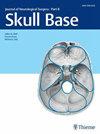The Eyelid Trans-orbital Trans-cavernous Approach to the Basilar Apex: A Cadaveric Proof-of-Concept Study
IF 0.9
4区 医学
Q3 Medicine
引用次数: 0
Abstract
Objective The pretemporal transcavernous approach is an elegant technique that provides exposure to the basilar apex, which is conventionally completed with a frontotemporal incision. This can also be performed via a minimally invasive eyelid transorbital approach, which has unique attributes. This is a proof-of-concept cadaveric study to demonstrate details of the combination of these two approaches. Design This study is a proof-of-concept study using cadaveric heads. Setting This study is a proof-of-concept study in a cadaveric laboratory. Participants A latex-injected cadaveric head. Main Outcome Measures Detailed dissection was performed and demonstrated in a step-by-step fashion. Results The eyelid transorbital approach provides the exact exposure required to complete the pretemporal osteotomy including an anterior clinoidectomy and dissection, so that a transcavernous approach can be completed. The basilar apex and its branches can also be accessed via the eyelid transorbital approach, with comparable exposure to the traditional approach; however, the access trajectory is much narrower. It takes advantages of the inferior corridor with a more medial access angle and provides a complementary perspective to the cavernous sinus contents and basilar apex complex. Conclusion The combination of an eyelid transorbital and pretemporal transcavernous approaches can achieve a deep exposure via a minimally invasive incision, which may add an additional approach to the cavernous sinus and basilar apex regions.眼睑经眶经腔入路至基底动脉窦:尸体概念验证研究
目的 颞前经眶入路是一种优雅的技术,它可以暴露基底顶,而传统的基底顶暴露是通过额颞切口完成的。这种方法也可以通过微创的眼睑经眶入路进行,具有独特的特性。这是一项概念验证尸体研究,旨在展示这两种方法结合的细节。设计 本研究是一项使用尸体头部进行的概念验证研究。环境 本研究是在尸体实验室进行的概念验证研究。参与者 注射乳胶的尸体头部。主要结果测量 按步骤进行详细解剖和演示。结果 眼睑经眶入路提供了完成颞骨前截骨所需的精确暴露,包括前侧蝶骨切除和解剖,从而可以完成经海绵入路。基底动脉顶及其分支也可通过眼睑经眶入路进行手术,其暴露程度与传统入路相当;但入路路径要狭窄得多。它利用下走廊的优势,以更内侧的角度进入,为海绵窦内容物和基底动脉尖复合体提供了一个互补的视角。结论 将眼睑经眶和颞前经阴道的方法结合起来,可以通过微创切口实现深度暴露,从而为海绵窦和基底动脉尖区域增加一个额外的方法。
本文章由计算机程序翻译,如有差异,请以英文原文为准。
求助全文
约1分钟内获得全文
求助全文
来源期刊

Journal of Neurological Surgery Part B: Skull Base
CLINICAL NEUROLOGY-SURGERY
CiteScore
2.20
自引率
0.00%
发文量
516
期刊介绍:
The Journal of Neurological Surgery Part B: Skull Base (JNLS B) is a major publication from the world''s leading publisher in neurosurgery. JNLS B currently serves as the official organ of several national and international neurosurgery and skull base societies.
JNLS B is a peer-reviewed journal publishing original research, review articles, and technical notes covering all aspects of neurological surgery. The focus of JNLS B includes microsurgery as well as the latest minimally invasive techniques, such as stereotactic-guided surgery, endoscopy, and endovascular procedures. JNLS B is devoted to the techniques and procedures of skull base surgery.
 求助内容:
求助内容: 应助结果提醒方式:
应助结果提醒方式:


